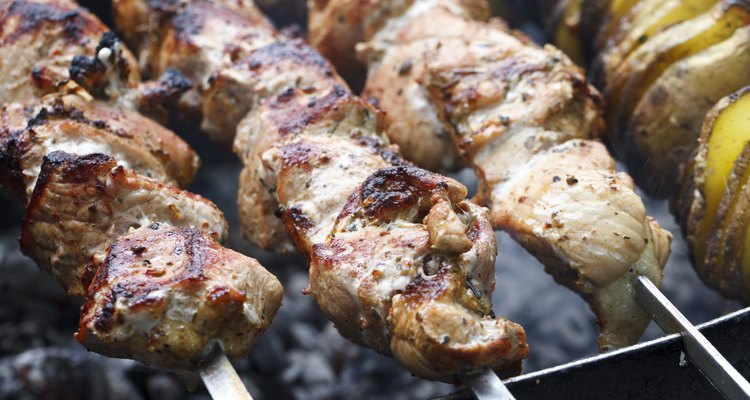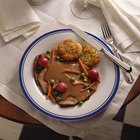
HOMONSTOCK/iStock/Getty Images
Lamb's delicate but distinctive flavor makes it a signature ingredient in many of the world's cuisines, where every part of the animal is associated with specific traditional dishes. Few Americans are familiar with some of the more exotic cuts, such as lamb breast. It's a relatively tough cut, taken from the animal's chest where the ends of its ribs meet the brisket. Its well-marbled meat is ideal for slow cooking, either by braising or slow-roasting the rolled breast.
Slow Roasting
Lay the deboned breast on a cutting board and check it carefully for small fragments of bone or gristle left behind by the butcher. Season the surface with salt and pepper, and other flavorings as desired.
Trim the breast into a neat rectangle, laying the trimmed-off pieces on the surface of the breast. Roll the breast into a tight cylinder, tying it tightly with cotton butcher's twine.
Heat a large skillet and sear the rolled lamb breast on all sides, until it's well browned. This step is optional, but it gives the roast a rich and savory flavor.
Preheat your oven to 275 degrees Fahrenheit. Make a mound of coarsely chopped onions, celery and carrots on the bottom of a small roaster or casserole dish, and rest the lamb on top of the aromatic vegetables. Cover the roaster or casserole with its lid or a sheet of heavy aluminum foil.
Roast the lamb for 3 to 4 hours, until the flesh is tender enough for the tines of a fork to slide in easily. Remove the roast from your pan to a serving tray, and cover it loosely with foil. Strain the cooking juices and skim off the fat that rises to the surface; thicken the juices to make a sauce. Serve the lamb and sauce together.
Braising the Breast
Trim away any small pieces of bone or gristle left in the deboned breast, and season it well with salt and pepper or other spices and herbs. Roll the breast into a tight cylinder, tying it in place with cotton butcher's twine.
Heat a large skillet or Dutch oven on your stovetop, and sear the rolled breast until it's well-browned on all sides. Move the lamb to a clean plate, and pour off any excess fat. Deglaze the pan or Dutch oven with a small amount of broth or red wine, stirring vigorously to dissolve all the browned-on juices.
Return the lamb to your Dutch oven, or place it in a casserole dish and pour the pan juices over it. Arrange onions, garlic or other aromatic ingredients around the lamb, as desired. Pour in enough water, broth, wine or other cooking liquid to immerse the rolled shoulder at least halfway.
Cover the lamb and slide it into an oven preheated to 325 F. Leave the breast to simmer gently in its cooking liquids for 3 to 4 hours, or until it's tender enough to easily remove a fragrant mouthful with your fork.
Transfer the lamb to a serving tray and cover it loosely with foil. Strain the cooking liquid from its pan and skim off the fat that floats to the top. Boil the liquid down to half of its original quantity, then thicken it if necessary with a small amount of cornstarch or flour. Serve this sauce with the lamb and your choice of side dishes.
Related Articles
How to Cook a Lamb Square Cut Shoulder

How to Cook a Small Lamb Shoulder

How to Cook a Deer Brisket

How to Cook a Deer Neck Roast in a Slow ...
How to Cook a Goat Shoulder

How to Cook Prime Rib Using an Oven ...
How to Cook Tender Peeled Knuckle

How to Bake a Pork Loin Center Half

Slow Roasting a Leg of Lamb Until It Is ...
How to Cook a Seven Bone Pot Roast in ...

How to Cook Shredded Pork Roast in a ...

How to Use an Electric Roaster to Slow ...

How to Use a Roaster Oven to Cook a ...

Extracting Bone Marrow for Cooking
How to Cook Buffalo Fillet

How to Cook a Beef Topside Roast

Roasting Instructions for a Half Loin ...

How to Tenderize Gizzards
Cooking Guide for Semi-Boneless Beef ...
How to Cook Boneless Lamb Butterflied ...
Resources
Writer Bio
Fred Decker is a trained chef and prolific freelance writer. In previous careers, he sold insurance and mutual funds, and was a longtime retailer. He was educated at Memorial University of Newfoundland and the Northern Alberta Institute of Technology. His articles have appeared on numerous home and garden sites including GoneOutdoors, TheNest and eHow.
Photo Credits
HOMONSTOCK/iStock/Getty Images